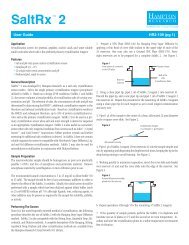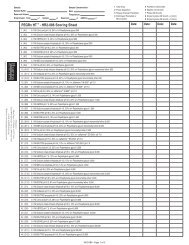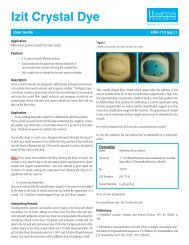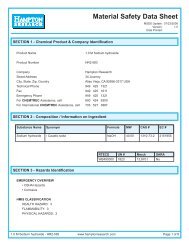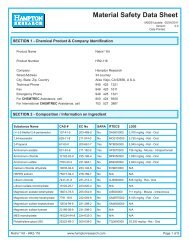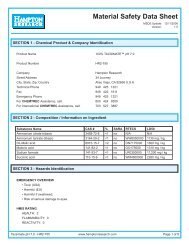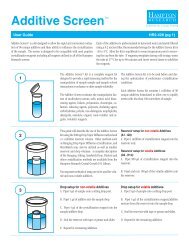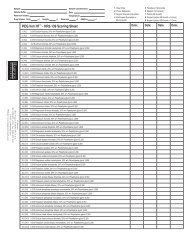Download - Hampton Research
Download - Hampton Research
Download - Hampton Research
Create successful ePaper yourself
Turn your PDF publications into a flip-book with our unique Google optimized e-Paper software.
Optimize - Silica Hydrogel kit<br />
application<br />
n Quick & easy kit format for crystallization in<br />
gels<br />
features<br />
n Proprietary Silica Hydrogel formulation with<br />
neutral pH<br />
n Gel matrix can reduce nucleation &<br />
sedimentation<br />
description<br />
Gels are a very efficient media for growing macromolecular crystals.<br />
1-5 Silica gels in particular have the advantage in that they are<br />
stable, usable over a wide range of temperatures (0-60°C), and are<br />
compatible with a wide variety of precipitants and additives used<br />
for crystal growth.<br />
Gels can reduce nucleation and sedimentation, provide added stability,<br />
and allow crystals to grow larger. The porous network minimizes<br />
natural convection. Crystals are suspended in the gel network<br />
so that they do not form sediments and can grow free from<br />
strain exerted by the container or other crystals. Heterogeneous<br />
and secondary nucleation are reduced in the presence of a Silica Hydrogel. 3 The Silica Hydrogel can<br />
be used for liquid-gel, liquid-gel-liquid, vapor diffusion, as well as dialysis crystallization methodologies.<br />
The gel is compatible with a wide range of salts, polymers, organic solvents, and buffers used for<br />
macromolecular crystallization in a pH range from 3 to 10.<br />
Each Silica Hydrogel kit contains 12 tubes of Sodium silicate solution and 12 tubes of Acetic acid solution,<br />
500 µl each. All solutions are sterile filtered and formulated using ultra-pure water. Crystallization<br />
accessories are sold separately.<br />
References<br />
1. Robert, M.C. & Lefaucheux, F., J. Crystal Growth (1988) 90, 358.<br />
2. Provost, K. & Robert, M.C., J. Crystal Growth (1991) 110, 258.<br />
3. M.C. Robert, K. Provost, & F. Lefaucheux, Crystallization of Nucleic Acids and Protein, A Practical Approach, Oxford Univ Press (1992) 127-143.<br />
4. McPherson A., Methods in Enzymology (1985) 114, 112.<br />
5. Cudney, B., Patel, S., McPherson, A., Acta Cryst. (1994) D50, 479-483.<br />
Order Information<br />
Cat. No. Name Description Price<br />
application<br />
n Crystallization in agarose gel<br />
features<br />
n Gel matrix can reduce nucleation and sedimentation<br />
n Crystallization grade<br />
n Low melting agarose<br />
HR2-310 Silica Hydrogel 500 µl, 24 tubes $95.00<br />
description<br />
Low melting (LM) agaroses are the result of a derivatization process<br />
by organic synthesis. The main properties of these agaroses are<br />
their low melting and gelling temperatures when compared with<br />
standard agaroses. LM agaroses have higher clarity (gel transparency)<br />
than gels of standard agaroses. The gelling temperature of<br />
LM agaroses is 24 to 28°C.<br />
The structure of the polysaccharide is that of a galactan, formed by linking agarobioses by links 1-3, 1-4.<br />
This chemical structure gives agaroses the capacity to form strong gels even at low temperatures. The<br />
gels have a macroreticular structure with a very open mesh which can be adjusted simply by varying<br />
the concentration of the agarose. The macroreticule structure of the agarose gel is formed by hydrogen<br />
bonds, which makes the gel reversible, transforming the gel into a solution by heating. The absence<br />
of ionic groups makes the gel a neutral structure. With no interaction, macromolecules can migrate<br />
through the gel mesh, making the gel an efficient sieve for biological macromolecules.<br />
Order Information<br />
Optimize - LM Agarose<br />
Cat. No. Name Description Price<br />
HR8-092 LM Agarose 10 g $58.00<br />
optimize crystallization grade reagents<br />
57



